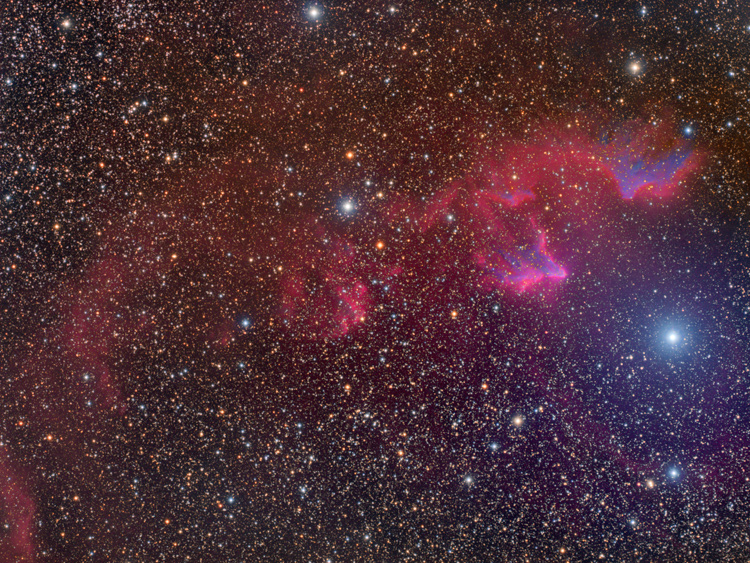|
|
Click the image for a larger
view. (1600 x 1200 - 1.23 MB)

Click the image for a larger
view. (1676 x 1257 - 1.23 MB)
|
Instrument |
Takahashi FSQ-106ED @
f/5.0 (530 mm F.L.) Captured at 2.1 arcsec/pixel. Shown at 4.2
and 8.96 arcsec/pixel. |
|
Mount |
Losmandy G11 with Gemini L4 v1.0 |
|
Camera |
SBIG STF-8300M Self
Guiding Package w/ mono ST-i, using an AstroDon 5nm Ha & Baader RGB filters. |
|
Acquisition Data |
9/20/2014 to
10/6/2014
Chino Valley, AZ |
|
Exposure |
|
Ha |
480 min. (32 x
15 min.) binned 1x1 |
|
Red |
196 min. (28 x
7 min.) " |
|
Green
|
196 min. (28 x 7 min.)
" |
|
Blue
|
392 min. (56 x 7 min.)
" |
eXcalibrator RGB
ratios are 1.00, 1.20 & 1.42
Click
here for an Ha filtered b/w image. |
|
Software |
-
CCDSoft, CCDStack,
PixInsight & Photoshop CS6.
-
No SDSS stars were
available for color balancing, so a standard image-train
calibration was used, as determined by
eXcalibrator v4.30, and then adjusted for altitude
extinction.
-
CCDStack to
calibrate the sub exposures.
-
PixInsight
processing includes registration and stacking the sub exposures,
creating the RGB image, gradient repair, the initial non-linear
stretching with HistogramTransformation and MaskedStretch.
-
PhotoShop to
create (upper) [HaR]GB image and final touch up.
The stars were slightly dimmed by first selecting them with a
PhotoShop action. The
lower image uses
Rob Gendler's method for adding Ha data to an RGB image.
-
Noiseware 5, a
PhotoShop plug-in.
|
|
Comment |
North is to the top.
IC 59 & 63, the Ghosts
of Cassiopeia, are located about 600 light years from Earth. IC 59,
the "ghost" at the upper right, is classified as a reflection
nebula. IC 63, to the left and lower, is classified as an emission
nebula. However, it does show some blue reflection components. Their
main source of illumination is the nearby 2.15 magnitude star Gamma
Cassiopeia. |
|